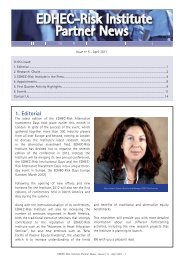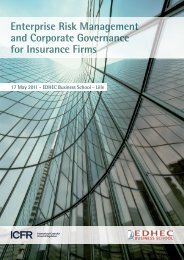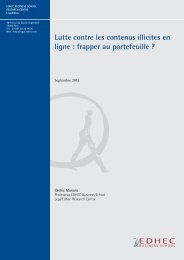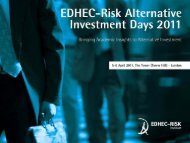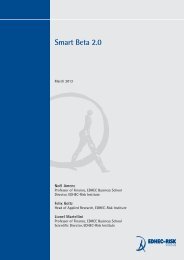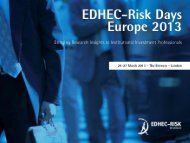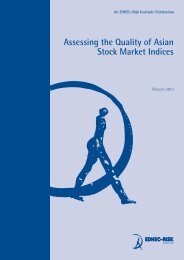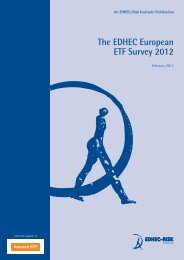The Smart Beta 2.0 Approach - EDHEC-Risk
The Smart Beta 2.0 Approach - EDHEC-Risk
The Smart Beta 2.0 Approach - EDHEC-Risk
You also want an ePaper? Increase the reach of your titles
YUMPU automatically turns print PDFs into web optimized ePapers that Google loves.
An ERI Scientific <strong>Beta</strong> Publication — <strong>Smart</strong> <strong>Beta</strong> <strong>2.0</strong> — April 2013<br />
Copyright © 2013 ERI Scientific <strong>Beta</strong>. All rights reserved. Please refer to the disclaimer at the end of this document.<br />
11<br />
1. <strong>The</strong> <strong>Risk</strong>s of <strong>Smart</strong> <strong>Beta</strong> Strategies<br />
Exhibit 2: Weight profile of <strong>Smart</strong> <strong>Beta</strong> strategies – <strong>The</strong> figure plots the ratio of stock weight in the following Scientific <strong>Beta</strong> USA strategy indices<br />
– Efficient Max Sharpe, Efficient Min Volatility, Diversified <strong>Risk</strong> Parity, Max Decorrelation, and Max Deconcentration – to stock weight in the capweighted<br />
index based on same stock universe. <strong>The</strong> weights at the rebalancing date of 21 December 2012 are used for the analysis. Data on constituent<br />
weights and market cap weights was downloaded from www.scientificbeta.com.<br />
Exhibit 3: Factor Exposures of Commercial <strong>Smart</strong> <strong>Beta</strong> Equity Strategies – <strong>The</strong> table shows the risk factor exposures of FTSE RAFI U.S. 1000 Index,<br />
FTSE <strong>EDHEC</strong> <strong>Risk</strong> Efficient U.S. Index, MSCI USA Minimum Volatility Index, and S&P 500 Equal Weight Index using the Carhart 4 factor model (Carhart,<br />
1997). <strong>The</strong> Market factor is the daily return of cap-weighted index of all stocks that constitute the Scientific <strong>Beta</strong> USA universe. SMB factor is the daily<br />
return series of a portfolio (cap-weighted) that is long the top 30% of stocks (small market-cap stocks) and short the bottom 30% of stocks (large<br />
market-cap stocks) sorted on market capitalisation. HML factor is the daily return series of a portfolio (cap-weighted) that is long the top 30% of<br />
stocks (value stocks) and short the bottom 30% of stocks (growth stocks) sorted on book-to-market value. MOM factor is the daily return series of a<br />
portfolio (cap-weighted) that is long the top 30% of stocks (winner stocks) and short the bottom 30% of stocks (loser stocks) sorted on past returns in<br />
descending order. <strong>The</strong> yield on Secondary US Treasury Bills (3M) is used as a proxy for the risk-free rate in US Dollars. <strong>The</strong> following regression is run<br />
for each index over the period of analysis.<br />
(1)<br />
Daily total return data for all indices has been obtained from Datastream and factor returns are obtained from www.scientificbeta.com. Period of<br />
analysis is from 23 December 2002 to 31 December 2012 and betas significant at the 1% confidence level are highlighted in bold. Reported alphas<br />
are geometrically averaged and are annualised.<br />
FTSE RAFI U.S. 1000<br />
Index<br />
FTSE <strong>EDHEC</strong> <strong>Risk</strong><br />
Efficient U.S. Index<br />
MSCI USA Minimum<br />
Volatility Index<br />
S&P 500 Equal Weight<br />
Index<br />
Annualised Alpha 2.3% 3.3% 2.9% 2.7%<br />
Market <strong>Beta</strong> 97.9% 93.1% 79.9% 102.4%<br />
Size (SMB) <strong>Beta</strong> 14.8% 39.9% -5.8% 40.5%<br />
Value (HML) <strong>Beta</strong> 15.8% 0.4% 4.7% 1.5%<br />
Momentum (MOM) <strong>Beta</strong> -11.6% -5.6% -0.7% -8.1%<br />
Adjusted R-square 98.5% 98.7% 95.1% 98.9%<br />
strategy that deviates from cap weighting, and hence avoiding this feature, is expected to show a<br />
negative exposure to the momentum factor. 6<br />
6 - For more discussion, please refer to Amenc, Goltz, Martellini and Ye (2011).




